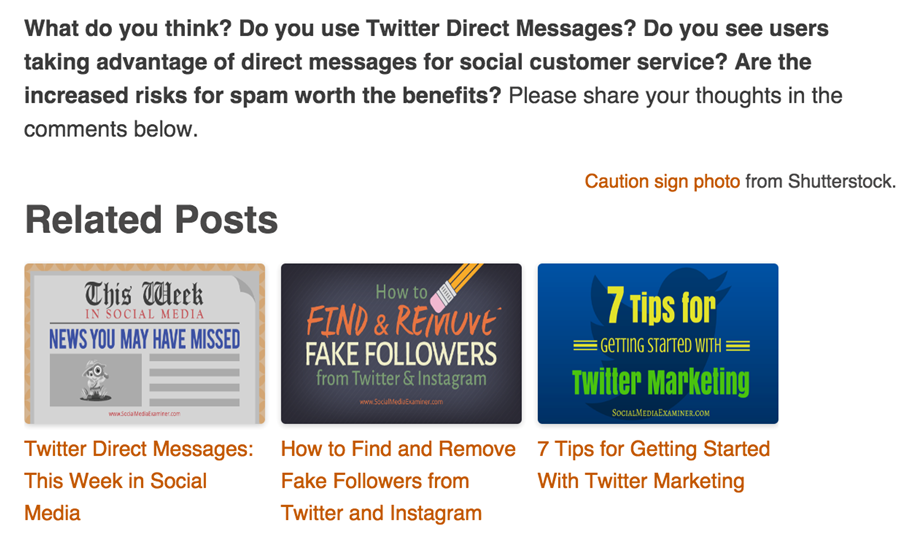If you have a blog, but feel that your visitor's engagement with your blog is minimal at best, then this post is for you. In this post, we're going to look at eight ways you can increase blog engagement for more comments, social shares, and links.
1. Don’t obscure your content
Do you have ads on your blog? Do you have email opt-in popups? If you have something that is getting in the way of your visitors finding and consuming your content, then you have to ask yourself if blog engagement is truly your goal. If it is, you need to remove them or restructure them so that they do not interfere with your content.
The site shown below, for example, has about eight ad blocks in this small section of the screen, all of which must be reloaded when you move to the next slide.

The mobile site is about the same, if not worse. Some things don't even load due to the number of ad servers the site needs to connect with. In short, not only are they obscuring their content, but they are also killing their page load time, which means more visitors are abandoning the page than engaging with the content.
2. Write about your target audience's main interests
Chances are, your blog isn't about you. It's about your audience. Whether they are your readers or your customers, you want to create content that caters to your target audience's interests. If you don't know what those interests are, find out using simple survey tools like Qeryz.
 You can ask your audience about specific categories, as shown in the example above, or ask what topics they'd like you to cover next. This tactic will help you increase engagement because readers will be excited that you are in tune with their interests.
You can ask your audience about specific categories, as shown in the example above, or ask what topics they'd like you to cover next. This tactic will help you increase engagement because readers will be excited that you are in tune with their interests.3. Include something in your content that others don't
Let's say you want to write about a topic that has been written about many times before, like creating Facebook pages. Before you begin writing, you need to look at the top posts on creating a Facebook page to see what is missing. There has to be something that you know about this topic that others have not already shared.
 Maybe you notice that no one has included a screenshot (as shown above) of the helpful chartsFacebook provides to help you choose which page category to choose or what administrator role to give to your employees. Or maybe you notice that no one tells people that they can have local business pages without turning on reviews.
Maybe you notice that no one has included a screenshot (as shown above) of the helpful chartsFacebook provides to help you choose which page category to choose or what administrator role to give to your employees. Or maybe you notice that no one tells people that they can have local business pages without turning on reviews.
Once you've figured out some unique tidbits, include them in your post. This tactic will ensure that you get comments, social shares, and links because people will be impressed that you were able to shed new light on a familiar topic.
4. Get visual
If you are writing about something that you can include specific visuals for, such as screenshots or photographs, include them. Anyone can write a post on Google Analytics and say there is a great feature that allows you to compare your traffic to the previous period, but the person that shows a beginner where that option is (as shown below) provides the most useful content.
 For those that need screenshots, Jing is a free, easy tool to use for capturing and annotating. For those that need photographs, look no further than your own smartphone.
For those that need screenshots, Jing is a free, easy tool to use for capturing and annotating. For those that need photographs, look no further than your own smartphone.
This tactic should ensure that you get comments, social shares, and links because people will be excited about your content.
5. Back it up with data
People are more likely to share content from sources they trust. Put some data behind your claims to build trust. For example, don't simply say that Optimizely is the most popular A/B testing tool used on the web. Back it up with a little data from BuiltWith.
 This tactic will give your readers confidence that your advice is sound, making them more likely to share it on social media and link to it. For additional links, find some new data to share through your own research and become the site that everyone links to when quoting sources in their own posts.
This tactic will give your readers confidence that your advice is sound, making them more likely to share it on social media and link to it. For additional links, find some new data to share through your own research and become the site that everyone links to when quoting sources in their own posts.6. Choose the best comment system
Take a look at the top blogs in your niche, especially the ones that get a lot of comments. What you want to look for is the comment system they use. If you notice most blogs in your niche are using Disqus, Facebook or a similar system, you may want to consider using that comment system for your blog.
Why? Because it is what your audience is used to. If you already have a strong community like Moz, you can get away with a proprietary, login-only comment system. If not, you need to go with what readers are most likely to use.

Alternatively, if you see a popular blog in your niche that doesn't get a lot of comments using a particular system, avoid that one at all costs. The fewer barriers to entry your readers must overcome to comment, the more likely they are to do so.
7. Ask for engagement
Don't simply hope that people will know what to do after they have read a great blog post. Ask for the engagement you want, preferably at the end of each post.
One great way to encourage engagement is to ask your readers about their thoughts and experiences with regard to the topic at hand. Ask them what their burning questions are, similar to what Social Media Examiner does at the end of their posts.
 Ask them to engage. And once they do, be sure to respond to their questions and comments.
Ask them to engage. And once they do, be sure to respond to their questions and comments.
When you start engaging with your audience on a frequent basis, they will be more likely to return to your blog more often for future updates. If you have guest authors or freelance writers creating content for you, be sure they engage with the comments on their posts to keep your blog community active.
8. Promote your content
Once you create engaging content, you need to get it out there to make sure you it receives the attention you seek.
Remember to ask for engagement as you promote your content, much like Buffer does in the screenshot below. While you may end up with engagement offsite, like in the comments on your Facebook page, you will most likely get it on your blog, too, when people go their to read your posts.
 It's essential that you brainstorm some questions you can ask your audience in relation to your posts. Each question can be used when you promote your posts on social media networks. For those that promote their content multiple times to social media networks, each question can be used to create a unique status update.
It's essential that you brainstorm some questions you can ask your audience in relation to your posts. Each question can be used when you promote your posts on social media networks. For those that promote their content multiple times to social media networks, each question can be used to create a unique status update.
 It's essential that you brainstorm some questions you can ask your audience in relation to your posts. Each question can be used when you promote your posts on social media networks. For those that promote their content multiple times to social media networks, each question can be used to create a unique status update.
It's essential that you brainstorm some questions you can ask your audience in relation to your posts. Each question can be used when you promote your posts on social media networks. For those that promote their content multiple times to social media networks, each question can be used to create a unique status update.
Using engaging questions is a great way to promote your blog posts in groups.
This approach also works great for email lists. You can a question in the subject line to intrigue subscribers, or in the body of the email to encourage subscribers to click through, read, and engage with your posts on your blog.
Derek Halpern of Social Triggers frequently uses this approach with emails promoting his blog posts:

This type of email makes you want to share your own thoughts on the subject, regardless of whether you are interested in his answer.
So not only do questions encourage people to engage with your blog content, but they also help you promote your content in ways that are sure to get you more traffic.
In Conclusion
You may wonder why I didn't mention blog commenting or general networking strategies to get more engagement on your blog content. Those are definitely good ways to go about increasing your own blog engagement, and they are well-known tactics you are probably already using. Heck, even Rand highlighted them in his tactics to increase blog traffic post.
The tips in this post are meant to be a valuable addition to the tactics you're already using to create a successful blog.
So now, it's your turn. How do you increase engagement for your blog posts? Let's discuss it in the comments.
To view the original article Click Here

Inspiring writings and I greatly admired what you have to say , I hope you continue to provide new ideas for us all and greetings success always for you..Keep update more information..Ecommerce Email Marketing Tips and Tricks
ReplyDelete